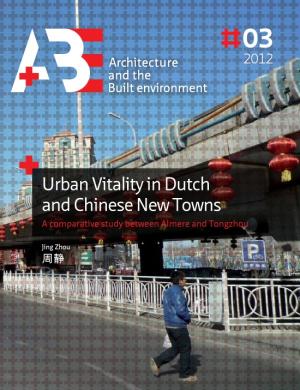Hosted by
Urban Vitality in Dutch and Chinese New Towns: A comparative study between Almere and Tongzhou
Synopsis
Building new towns seems to be a rational regionalization approach that releases pressure from overly burdened large cities. This strategy was developed in Western Europe in the middle of twentieth century. Since the 1990s, the European new town model has been widely implemented in China. However, the author questions the feasibility of the large-scale, hasty new town developments. The study of worldwide new town experiences, especially European and Chinese cases, demonstrates that many new towns in fact have difficulty in achieving a real sense of urban quality and vitality. So far, few research projects have been conducted to evaluate and develop solutions for this problem.
The purpose of this research project is therefore to identify the spatial and non-spatial factors and conditions that facilitate the development of urban vitality in new towns. It is aimed to reveal the impacts of spatial design, urban planning and governance approaches on the degree and patterns of local urban life of new towns in China and in the Netherlands. The generated knowledge of this research project helps develop not only a better understanding of the main problems of new towns, but also spatial strategies with the aim to enliven new towns and other types of (sub)urban areas as well. The central research question is approached through literature review and case studies.
The literature review provides a critical re-evaluation of the scientific validation of the new town model, especially the notion of town self-containment in economic terms. The relevant theories under study mainly include regional science and economic geography. The literature review also clarifies the general definition of urban vitality and its distinct meanings in different socio-economic and political backgrounds of the two societies, sets up the quantitative measurements methodology, and identifies a preliminary framework of spatial factors and conditions. As it turns out, the key indicators of urban vitality are the co-presence of people as well as the social, cultural and economic activities in public spaces. The primary conditions are categorized as attractor-determinism, space-determinism and people-determinism. In regard to the spatial factors, the focus is on the spatial configuration of street networks, the composition of urban blocks and neighborhoods, as well as the value of details on small scales. The non-spatial factors primarily include the changing urban planning and governance approaches. The systems approach of planning and control, and the decentralization of decision-making powers are of particular importance to the topic. Various urban vitality evaluation criteria are derived, and then applied and tested in the comparative case studies.
The Dutch new town Almere and the Chinese new town Tongzhou are both important new towns in their regions. They are selected based on their contrasting features as planned and market-driven, self-organized new towns, and the resultant differences in the level and character of their urban vitality. It is believed that their governments could gain inspiration from each other’s experiences for the future development of the towns. The key analytical approach of the case studies is to overlap multiple layers of top-down socio-spatial analyses with the actual space use from the bottom-up field investigations. The spatial analysis focuses on finding relations between the distribution of the planned and unplanned socioeconomic activities and the spatial configuration of different elements on different scales. Space syntax is adopted as one of the key analytical tools. The field study tasks include registering people’s movement of flows through static snapshots method, the mapping of self-organized small-businesses, activities and space appropriations, and conducting interviews and surveys of city officials, local people and shop owners.
The results of the comparative case studies show that there is a strong correlation between space and the socio-economic life in new towns. As a market-driven, spontaneous new town, streets are the key places for socio-economic activities in Tongzhou. An essential spatial condition stimulating dynamic street life is found to be the open grid network structure with the mixture of diverse commercial, cultural and public programs widely dispersed on street frontages. The proliferation of groundfloor small businesses at the perimeters of neighborhoods in Tongzhou constitutes a big part of the street life, especially for the areas near public transport stations. As a top-down planned town, Almere excels at effective planning control and responsible social considerations, which benefits the long-term well-being of the city. Good urban governance is reflected not only in the public provisions and city marketing, but more importantly, in the quality of the public services and the available opportunities of citizen participation. For example, adaptable architectural design and bottom-up community planning implemented in Almere has positive impacts on animating local and perspective inhabitants, hence increasing urban vitality in another dimension. Interestingly, many of the home-based small businesses in Almere thrive by virtue of internet platform, despite that the effect is subtle in terms of bringing street activities. Both new towns need to further develop and experiment with new approaches of urban planning. Such new approaches are intended to be capable of creating a framework for a dynamic system to grow, balancing the planned and unplanned elements, involving a diversity of interested parties in the development process, being adaptive to changes over time, and emphasizing the quality of life for their citizens.
Finally, the empirical and theoretical study findings are compared to each other. It results in a refined definition of urban vitality, which is synthesized into the placepeople-program triangle diagram, an enriched list of the favorable spatial conditions that are required to generate a sense of urban vitality, as well as a clear proposal for an upgraded urban planning and governance approach that is open to the complexity and uncertainty of contemporary societies.

